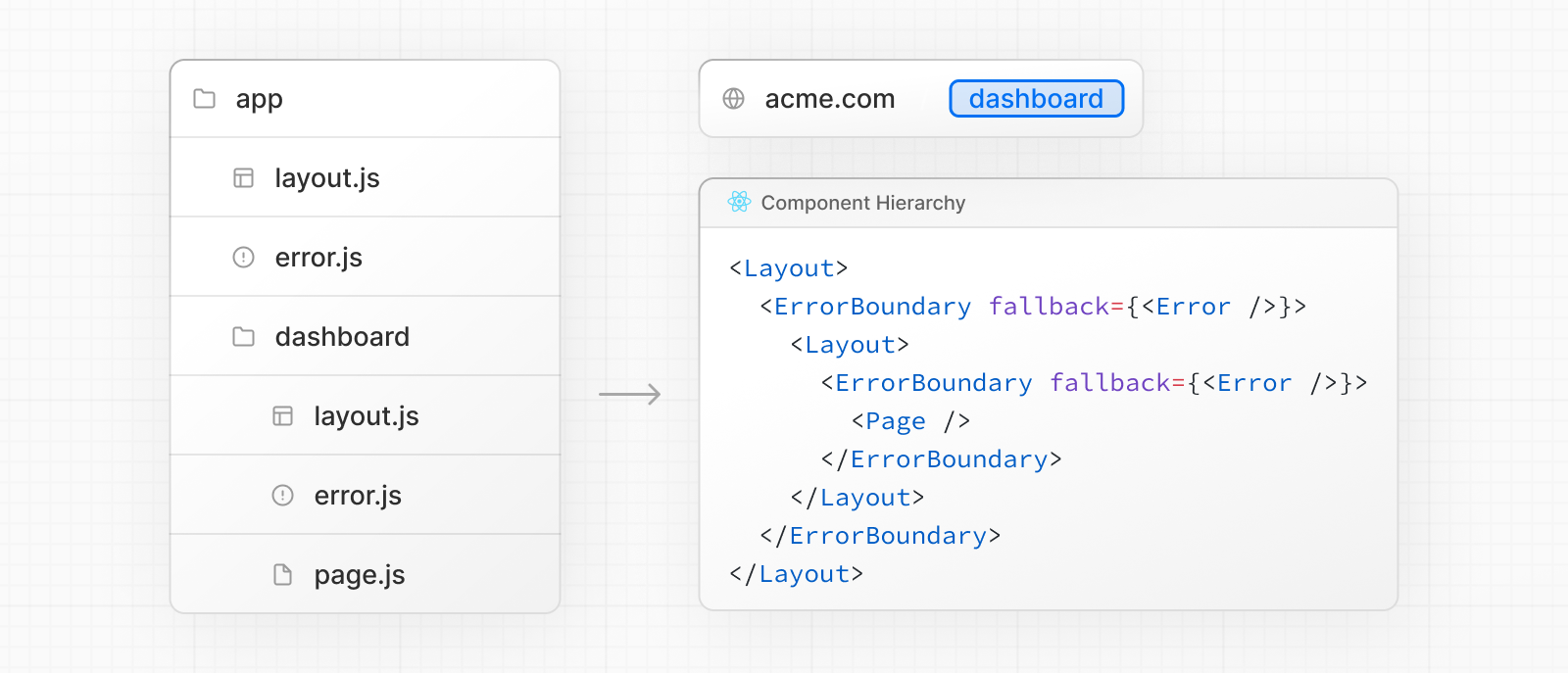外观
错误处理
错误处理
错误可以分为两类:预期错误和未捕获异常:
- 将预期错误建模为返回值:在服务器操作(Server Actions)中避免使用
try/catch处理预期错误。使用useActionState来管理这些错误并将它们返回给客户端。 - 使用错误边界处理意外错误:使用
error.tsx和global-error.tsx文件实现错误边界,以处理意外错误并提供备用UI。
提示
这些示例使用了React的useActionState钩子,该钩子在React 19 RC版本中可用。如果你使用的是早期版本的React,请使用useFormState代替。更多信息请参阅React文档。
处理预期错误
预期错误是那些在应用正常运行过程中可能发生的错误,例如服务器端表单验证或请求失败。这些错误应该被明确处理并返回给客户端。
处理来自服务器操作的预期错误
使用useActionState钩子来管理服务器操作的状态,包括处理错误。这种方法避免了对预期错误使用try/catch块,这些错误应该被建模为返回值而不是抛出的异常。
app/actions.ts
'use server'
import { redirect } from 'next/navigation'
export async function createUser(prevState: any, formData: FormData) {
const res = await fetch('https://...')
const json = await res.json()
if (!res.ok) {
return { message: 'Please enter a valid email' }
}
redirect('/dashboard')
}app/actions.js
'use server'
import { redirect } from 'next/navigation'
export async function createUser(prevState, formData) {
const res = await fetch('https://...')
const json = await res.json()
if (!res.ok) {
return { message: 'Please enter a valid email' }
}
redirect('/dashboard')
}然后,你可以将你的操作传递给useActionState钩子,并使用返回的state来显示错误消息。
app/ui/signup.tsx
'use client'
import { useActionState } from 'react'
import { createUser } from '@/app/actions'
const initialState = {
message: '',
}
export function Signup() {
const [state, formAction] = useActionState(createUser, initialState)
return (
<form action={formAction}>
<label htmlFor="email">Email</label>
<input type="text" id="email" name="email" required />
{/* ... */}
<p aria-live="polite">{state?.message}</p>
<button>Sign up</button>
</form>
)
}app/ui/signup.js
'use client'
import { useActionState } from 'react'
import { createUser } from '@/app/actions'
const initialState = {
message: '',
}
export function Signup() {
const [state, formAction] = useActionState(createUser, initialState)
return (
<form action={formAction}>
<label htmlFor="email">Email</label>
<input type="text" id="email" name="email" required />
{/* ... */}
<p aria-live="polite">{state?.message}</p>
<button>Sign up</button>
</form>
)
}你也可以使用返回的状态在客户端组件中显示一个提示消息。
处理来自服务器组件的预期错误
当在服务器组件内部获取数据时,你可以使用响应来有条件地渲染错误消息或redirect。
app/page.tsx
export default async function Page() {
const res = await fetch(`https://...`)
const data = await res.json()
if (!res.ok) {
return 'There was an error.'
}
return '...'
}app/page.js
export default async function Page() {
const res = await fetch(`https://...`)
const data = await res.json()
if (!res.ok) {
return 'There was an error.'
}
return '...'
}未捕获异常
未捕获异常是指在应用正常流程中不应发生的意外错误,表明存在bug或问题。这些应该通过抛出错误来处理,然后由错误边界捕获。
- 常见: 使用
error.js处理根布局下的未捕获错误。 - 可选: 使用嵌套的
error.js文件处理粒度更细的未捕获错误(例如app/dashboard/error.js) - 不常见: 使用
global-error.js处理根布局中的未捕获错误。
使用错误边界
Next.js使用错误边界来处理未捕获的异常。错误边界捕获其子组件中的错误,并显示一个备用UI,而不是崩溃的组件树。
通过在路由段内添加一个error.tsx文件并导出一个React组件来创建错误边界:
app/dashboard/error.tsx
'use client' // Error boundaries must be Client Components
import { useEffect } from 'react'
export default function Error({
error,
reset,
}: {
error: Error & { digest?: string }
reset: () => void
}) {
useEffect(() => {
// Log the error to an error reporting service
console.error(error)
}, [error])
return (
<div>
<h2>Something went wrong!</h2>
<button
onClick={
// Attempt to recover by trying to re-render the segment
() => reset()
}
>
Try again
</button>
</div>
)
}app/dashboard/error.js
'use client' // Error boundaries must be Client Components
import { useEffect } from 'react'
export default function Error({ error, reset }) {
useEffect(() => {
// Log the error to an error reporting service
console.error(error)
}, [error])
return (
<div>
<h2>Something went wrong!</h2>
<button
onClick={
// Attempt to recover by trying to re-render the segment
() => reset()
}
>
Try again
</button>
</div>
)
}如果你希望错误冒泡到父级错误边界,你可以在渲染error组件时throw。
处理嵌套路由中的错误
错误会冒泡到最近的父级错误边界。这允许通过在路由层次结构的不同级别放置error.tsx文件来进行粒度更细的错误处理。

处理全局错误
虽然不太常见,但你可以使用位于根app目录中的app/global-error.js来处理根布局中的错误,即使在利用国际化时也是如此。全局错误UI必须定义自己的<html>和<body>标签,因为它在激活时会替换根布局或模板。
app/global-error.tsx
'use client' // Error boundaries must be Client Components
export default function GlobalError({
error,
reset,
}: {
error: Error & { digest?: string }
reset: () => void
}) {
return (
// global-error must include html and body tags
<html>
<body>
<h2>Something went wrong!</h2>
<button onClick={() => reset()}>Try again</button>
</body>
</html>
)
}app/global-error.js
'use client' // Error boundaries must be Client Components
export default function GlobalError({ error, reset }) {
return (
// global-error must include html and body tags
<html>
<body>
<h2>Something went wrong!</h2>
<button onClick={() => reset()}>Try again</button>
</body>
</html>
)
}